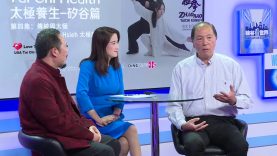硅谷養生太極第四集 – 傳統與太極 Thomas Hsieh 太極感悟
嘉賓:Title / 嘉賓簡介:
Thomas Hsieh
Just Retired as Senior Manager from Oracle America Inc.
Vice President of
USA Tai Chi Culture Association
Director of International Wushu Sanshoudao Association
Wayne Peng
The 12th General successor of Zhao Bao Tai Chi linage
President of USA Tai Chi Culture Association
Chairman of International Wushu Sanshoudao Association
十多年前,中文學校的太極文化班使我開始學習太極拳。初學太極拳,像很多人一樣,我也只是認為它是一個適合中老年人的運動,雖然陸續學了陳氏太極和楊氏太極的套路,但我學拳也只是來活動筋骨而已,並沒有想太多。直到我在學習了近五年後,突然發現打拳後,就算在寒冬,手腳也不會寒冷。心中漸漸了解到太極拳是有其獨到之處,但是也只是把它當作一種強身健體的有氧運動而已。這觀點直到彭文大師到中文學校教授趙堡太極才徹底改觀。
彭文大師的趙堡太極拳徹底顛覆了我對太極的刻板印象,彭文大師也進而讓我們得以看到太極拳武術應用的一面,雖然當時我尚無法理解的很多,但相對而言,當我學習了24式趙堡太極套路後,我直覺得的認為它非常適合初學者,不但容易上手而且打拳時氣亦較通順,尤其經過彭文師父對每招每式的用法不厭其煩的講演,使我對學習太極拳態度產生了莫大的變化。日後我陸續學了43, 56, 75式趙堡太極套路,愈發體會到其力、氣、神合為一的奇妙。
彭師父特有的教學方式及內容,讓同學們在不知不覺中去掉雙重的毛病,也漸漸培養出內力。除了拳架之外,彭文大師以推手來訓練同學的”聽力”。以擒拿和反擒拿來驗證學習成果。因為趙堡太極拳入門方式和其他太極拳不同,剛開始學拳時亦有其它太極同好很熱心的要”糾正”我,可是日子久了,他們也驚訝我們的進步,也漸漸認同彭師父是有其一套,不是”不對”而是”殊途同歸”。
以個人淺見,要入門太極,必要把我們的反射神經系統的直覺反應重新訓練起來。讓我們不要硬頂硬抗,不是不用力,而是要洞悉外力的方向及結構,然後全身順著對自己有利的方向施放巧力或卸去外力。簡單而言,就是要練出”人不知我,我獨知人。”的聽力。師父每每叮嚀和師兄弟練習時,要互相餵力,不要爭強鬥勝,務使大家在輕鬆的環境下,自然的增強身體聽力,再配以內力練習,達到熟能生巧,”一動無有不動”。更要求大家把太極時時配合在日常生活上。不怕大家笑,我都是用太極內力來開瓶罐的,否則只用蠻力我還真打不開的。
其實太極拳真的很難用語言文字來傳達,很多可意會不可言傳的法門,以師父再三叮嚀「再鬆、更鬆」,師兄弟間彼此領悟就大有不同。但是我發覺只要認真的把師父教的暖身操、氣功、拳架、站樁、推手‧‧等等,不打折扣的做下來,自然就「鬆」得快,反之則全身硬梆梆的。要學好「太極拳」真的要有明師指導,否則練了半輩子,依然只是和做有氧運動無異,而不能體會其精妙之處。每個人練太極拳都會有不同的感受,太極拳又是浩瀚無涯,每個階段都有不同的層次,但又不知自己距離另一階段有多遠。有時當你自以為你有新的領悟,過幾天又否定了。很多人認為學完拳架就好了,諸不知那才是開始。每一個階層都是冷暖自知。在學習的階段中,每個關卡,沒有師父指點,很少沒有灰心或放棄的,然後對人說太極”只是如此”。得彭師父教誨,教會我們這個可陪伴我們一生的「養生工具」實在是我們的幸運。也希望有更多人加入趙堡太極的大家庭。
About fifteen years ago, I started my long journey of Tai Chi by enrolling in a Tai Chi culture class offered at a local Chinese School. Like many others, I just regarded Tai Chi as a fitness exercise for the middle age. Even after I’ve learned several Chen and Yang styles of Tai Chi forms, I still treated Tai Chi as another relaxing health benefiting activity. After five years of Tai Chi practice, even in the mid of cold winter, I’ve found my limbs to be quite warm after practicing Tai Chi which started my appreciation of Tai Chi’s health benefits; However, I still thought of it is just another fitness exercise and not much more. This view has completely changed after grandmaster Wayne Peng started to teach us Zhao-Bao Tai Chi in the Tai Chi class.
By demonstrating the applications of Tai Chi for each form, master Peng has totally changed my impression of Tai Chi. Although I was unable to understand much then, after practicing Zhao Bao 24 forms, I instinctively felt it much suitable for beginners. Not only was it easier to practice but it made me feel my “Chi” flow much smoother. Master Peng has tirelessly explained the key points of each form and how to apply them during hand to hand combat situations. This kind of teaching technique has changed my attitude toward what and how to learn Tai Chi. Since starting this study, I’ve progressed to 43, 56, and 75 Zhao Bao Tai Chi forms; And with each form, my appreciation increases for alignment of strength, chi, and mind altogether when practicing those forms.
With master Peng’s unique teaching methodology and guidance, not only has he effectively minimized the “double weighted” issue, but he has also gradually cultivated internal energy for each student. In addition to practicing forms, master Peng focuses on push hands to boost students’ “Sensing” capability. Grappling and anti-grappling are being used to confirm the correctness of forms and enhancing internal energy. Zhao Bao Tai Chi learning approaches are quite different from other Tai Chi branches. At first, many friends of mine who have practiced Tai Chi for many years tried to “correct” me, but as time went by, they were surprised to see my progress, and gradually recognized master Peng’s teaching approach as being just as effective.
It is my opinion that it is necessary to retrain one’s reflexes in order to understand Tai Chi. One shall not intuitively counter external force with the brute force of our own. Instead, one should be able to sense the direction and strength of those forces and let the body to redirect those forces away from us using minimum effort. In other words, make your opponent become a pawn in your chess game. To reach that level will require many years of practice in a friendly environment. Master Peng constantly reminds everyone to learn how to “feed” the right amount of force to each other during push hands practice instead of trying to overpower one another. Under this environment, everyone gradually increases their “sensing power”, internal energy, and coordination of the whole body. Master Peng also wants to apply these practices in daily life. For example, I learned to use internal energy to open jars and bottles with ease.
It is difficult, if not impossible, to master Tai Chi plainly based on words. It is necessary to “feel” in person in order to realize each key element. For example, when the master wants us to be “more relaxed”, each person will interpret this guidance differently. Yet, if we follow the exact process instructed by the master, then muscles would relax much easier and our forms will be performed much smoother. Without guidance from a good master, people will not be able to correct their mistakes or bad habits. It is also very difficult to have clear measurements for which level you are now in Tai Chi. Many people think that they “understand” Tai Chi after being fluent with their Tai Chi forms. What they don’t know is that it is just the beginning. During the course of Tai Chi learning, sometimes when you think you have a breakthrough, you find yourself back to square one only a few days later. All of this can cause much frustration; leading people to decide to give up on Tai Chi. Yet, with a good master on your side, most of your frustrations can be resolved. We are lucky to have master Pang help us to learn these wonderful lifelong skills for better health and I hope more people can come and join the family of Zhao Bao Tai Chi.






